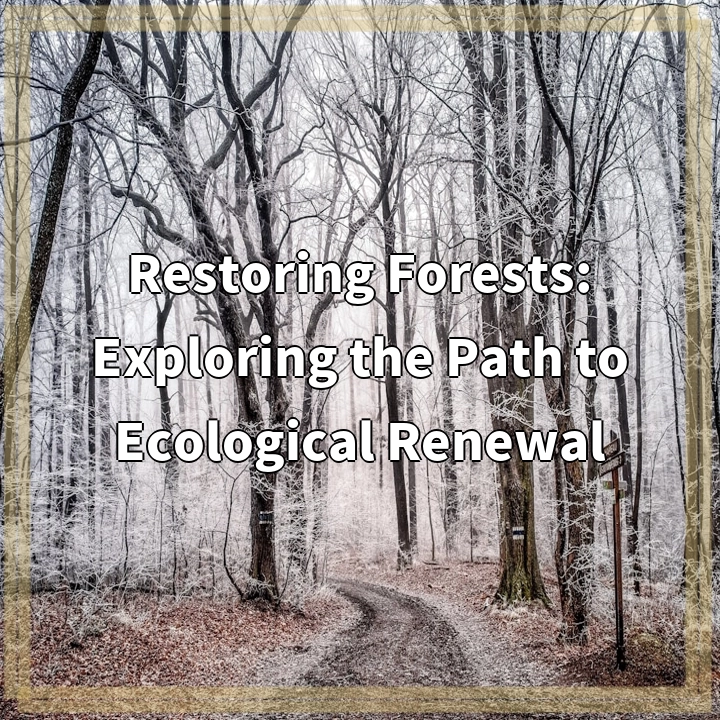
Restoring Forests: Exploring the Path to Ecological Renewal
What is Forest Restoration?
Forest restoration is the deliberate and planned process of renewing or rehabilitating degraded or destroyed forests. It involves the active intervention to restore ecological functions, enhance biodiversity, and improve ecosystem services. Restoration efforts typically focus on repairing damage caused by human activities such as deforestation, logging, mining, or wildfires.
Real-World Problems Associated with Forest Restoration
While forest restoration is a crucial endeavor, it faces several challenges and obstacles:
1. Deforestation Pressures:
The primary driver of forest degradation is deforestation. Ongoing practices such as clearing land for agriculture, urbanization, and infrastructure development continue to threaten forests worldwide. Efforts to restore forests must tackle the underlying causes of deforestation to ensure long-term success.
2. Limited Financial Resources:
Restoration projects require significant financial resources, including funding for research, planning, implementation, and monitoring. Securing adequate funding for large-scale restoration initiatives can be challenging, especially in economically disadvantaged regions.
3. Ecological Complexity:
Each forest ecosystem is unique, with distinct flora, fauna, and ecological processes. Restoring forests involves understanding and addressing complex ecological relationships. Adapting restoration strategies to specific site conditions and ecosystem characteristics is crucial for success.
4. Invasive Species and Pest Management:
Invasive species pose a significant threat to restored forests. These non-native plants and animals can outcompete native species, disrupt natural processes, and hinder ecosystem recovery. Effective pest management strategies are essential during the restoration process.
5. Community Engagement:
Sustainable forest restoration requires the active participation and support of local communities. Engaging communities in the restoration process, providing education and incentives, and addressing social and economic concerns are vital for long-term success.
Despite these challenges, forest restoration offers immense opportunities for addressing biodiversity loss, mitigating climate change, and safeguarding ecosystem services. By overcoming these real-world problems and implementing effective restoration strategies, we can pave the way for a greener and more sustainable future.

Restoring Forests: Exploring the Path to Ecological Renewal
Solutions to Real-World Problems
1. Addressing Deforestation Pressures:
To effectively restore forests, it is crucial to address the root causes of deforestation. This requires implementing sustainable land-use practices, promoting responsible agricultural practices, and enacting policies that prioritize forest conservation and restoration.
2. Mobilizing Financial Resources:
Securing adequate funding for forest restoration projects is essential. Governments, international organizations, and private sector entities can play a role in providing financial resources. Innovative funding mechanisms, such as carbon offset programs or public-private partnerships, can help leverage resources for large-scale restoration initiatives.
3. Adaptive Ecological Approaches:
Recognizing the ecological complexity of forests, restoration efforts should adopt adaptive approaches. This involves conducting thorough ecological assessments, identifying appropriate native species for restoration, and considering the potential impacts of climate change on future forest ecosystems. Implementing adaptive management techniques ensures that restoration strategies respond to the changing environmental conditions.
4. Effective Pest and Invasive Species Management:
To prevent the negative impacts of invasive species on restored forests, proactive management strategies are essential. This includes early detection and rapid response to the introduction of invasive species, implementing effective control measures, and promoting partnerships with local communities for ongoing monitoring and stewardship.
5. Engaging Local Communities:
Successful forest restoration requires the active involvement and support of local communities. Engaging communities through education, awareness campaigns, and capacity-building programs fosters a sense of ownership and ensures the long-term sustainability of restoration efforts. Addressing socio-economic concerns and providing tangible benefits to local communities can further strengthen community engagement.
By implementing these solutions, we can overcome the real-world challenges associated with forest restoration. With concerted efforts and collaborative action, we can restore and conserve forests, protecting their vital ecological functions and contributing to a healthier, more sustainable planet.















